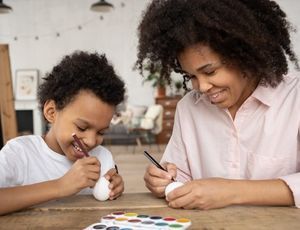Books for Art Lovers
What would our world be without art? We rely on it to record our history, to express our thoughts and emotions, to communicate, to protest, and to pass the time. Flexing our creativity feels good, and admiring the artwork of others has the potential to evoke a range of experiences.
Maybe you already love visual art. Perhaps your child has expressed some interest. Or maybe you’re just looking for some new good books to read together. No matter your reason, we’ve got you covered. As always, we’re including titles for readers of all developmental levels, as well as links to learn more.
Board Books
My Favorite Color by Aarom Becker
Becker is a Caldecott winner, so you already know this book is going to be gorgeous. Kids change their favorite color all the time, and this book celebrates the glorious spectrum of hues with fun semi-transparent segments.
ABCs of Art by Sabrina Hahn
Imagine a classic children’s ABCs book combined with beautiful classic works of art, and that’s what Hahn has created. From Cezanne to Stubbs, with all the Hokusai and Monet we could wish for our infants and toddlers wedged in between, you’ll love this book as much as your little one.
Picture Books
Ablaze With Color: A Story of Painter Alma Thomas by Jeanne Walker Harvey, illustrated by Loveis Wise
Art and creativity had always been a part of Thomas’ life, but it wasn’t until her 60s that she chose to pursue it as a career. This book covers the racial injustices faced by Thomas and her family, as well as the strange and beautiful journeys our lives take.
Funny Bones: Posada and His Day of the Dead Calaveras by Duncan Tonatiuh
José Guadalupe Posada, the Mexican artist known to many as Lupe, enjoyed using a variety of artistic mediums for a variety of purposes. From lithography to engraving, political cartoons to the Calaveras drawings he became famous for, art was always a part of his life.
Winner of the Robert F. Sibert Medal and a Pura Belpre Honor Book.
Radiant Child: The Story of Young Artist Jean-Michael Basquiat by Javaka Steptoe
Winner of the Caldecott Medal and the Coretta Scott King Award, Steptoe’s biography of Basquiat highlights the idea that art doesn’t need to conform to be beautiful.
Middle Grade
From the Mixed-Up Files of Mrs. Basil E. Frankweiler by E.L. Konigsburg
Claudia talks her brother into running away with her, and they end up secretly living in the Metropolitan Museum of Art in New York City. The two then get caught up in solving the mystery of a statue, and eventually realize they’re better off facing their problems at home.
Many Points of Me by Caroline Gertler
Georgia stumbles upon a drawing made by her father (a famous artist) before he died. She struggles to find meaning in the drawing, which seems to leave her out. Her quest to discover answers leads her, like the characters in our other middle grade recommendation, to the Met.
Nonfiction
Drawing From Memory by Allen Say
Say is another Caldecott winner, and this book is a fascinating autobiography complete with illustrations and photographs. Artists and their passions aren’t always supported, and we are all sometimes met with challenges that seem insurmountable. Say shares his journey, and how he managed to stay true to his dreams.
Fun and Easy Crafting with Recycled Materials: 60 Cool Projects That Reimagine Paper Rolls, Egg Cartons, Jars and More! by Kimberly McLeod
The title says it all. Some of the projects include toilet paper tube owls, 3-D hot air balloons, scrap paper trees, pirate hats, and a castle.
A World of Animals: Learn to Draw More Than 175 Animals From the Seven Continents!
by Rimma Zainagova
This book is perfect for animal lovers, geography lovers, and art lovers! Containing interesting factual information about the continents and zoology, there are lots of simple step-by-step drawing instructions that kids will love.
Graphic Novels
Before They Were Artists: Famous Illustrators as Kids by Elizabeth Haidle
A gorgeous anthology of shortened artist biographies, this book explores how artists’ lives during their early years. How is creativity nurtured, and what is it like when an artist is just beginning to discover their passions? Artists include Hayao Miyazaki, Trove Jansson, Maurice Sendak, Yuyi Morales, Wanda Gag, and Jerry Pinkney.
Doodleville by Chad Sell
Drew loves to draw, and somehow her creations actually come to life. This is great, until she draws a monster. She relies on her artistic friends to help her solve this tricky problem.
Young Adult
Making Comics by Lynda Barry
Barry is an associate professor at the University of Wisconsin-Madison, where she teaches students about art and discovery. This book is essentially her curriculum; it encourages students to see drawing as a means of expression and communication, and to stop worrying so much about artistic talent.
Drawing Dragons by Sandra Staple
If your teen loves drawing and fantasy worlds, this is the perfect pick for them. Along with specific instructions for learning to draw a variety of dragons, this book gives some very helpful information about drawing techniques in a general sense.
Little Felted Animals: Create 16 Irresistible Creatures with Simple Needle-Felting Techniques by Marie-Noelle Horvath
Your heart might just melt flipping through these pages. Learn to create a felted polar bear, sheep, dalmatian, and much more with detailed instructions and information about the materials needed to get started.
Mending Matters: Stitch, Patch, and Repair Your Favorite Denim and More by Katrina Rodabaugh
Clothing repair and design meets slow fashion meets artistry. Rodabaugh’s book inspires readers to grab their old torn jeans, some contrasting thread, and make something beautiful.






